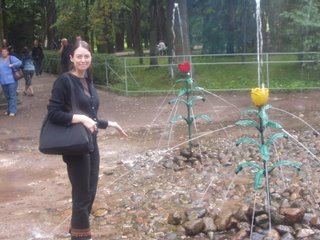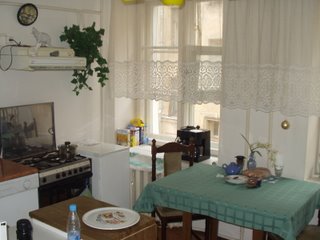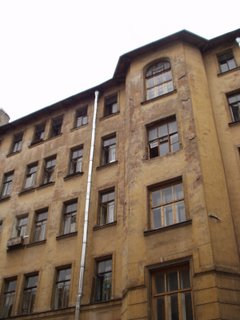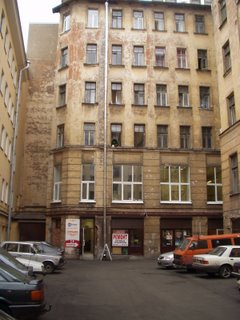The week since Scott left has been busy. I hope in general to update my comments every week on the weekend, but this past weekend I had local tasks that all took longer than I expected! So it goes. Almost right away I got the chance to help a local environmental organization with some GIS (electronic mapping) work: they are preparing information for the public about green spaces that have been lost to unregulated construction, and the lost spaces needed to be added to the digital map. I had a list of them along with old pictures of how they looked from above, where there were trees etc. It was a great way to get to know the city better, since I wasn’t familiar with all the parks and street names. So far there were 30 locations, and my contact in the organization says there are likely to be more.
About a block from where I live there has been a running street spectacle since a few days before Scott left. At the intersection of Sadovaya and Gorokhovaya streets (both of which Scott learned to pronounce perfectly) the street lights went out. Both streets are significant arteries around the center of the city, so you would think that they would fix it immediately, but there was no sign of that for a week. Two days ago it seemed they had it on again, but today I noticed that all the little screens were black. This means (the street spectacle part) that the cars and pedestrians have to negotiate spontaneously how everyone is going to get across the intersection, and in what rhythm. The traffic along Sadovaya seemed to dominate most of the time, so cars would back up along Gorokhovaya in both directions along with pedestrians on the corresponding corners. It interested me that the pedestrians were usually the ones to give the signal. After a certain accumulation of frustration, the collection of people would surge slowly into the street. One more car might squeeze through, but then it was all over for them (because who is going to run over 100 people?) and they had to wait until the flow of pedestrians thinned. The cars going along Gorokhovaya had then to catch their opportunity and drive through before the aggressive flow down Sadovaya took over once again. I wish I could film it from above.
Today I bought a loaf of bread for my friends, since I was there for breakfast and ate my share of slices. Before you couldn’t buy pre-sliced bread in plastic bags; you bought it fresh at a bakery and sliced it yourself all the time. Now you can do either. In line with me at the little 24-hour store (tucked into a basement space of an old building along Moskovskii Avenue) were a large number of teenagers or twenty-somethings… maybe on break from their classes in a nearby institute. A lot of them were buying Cheetos and Lay’s potato chips and soft drinks – other things that of course didn’t used to be here.
I have a few choices of places to buy food. My favorite is called Dieta, and it’s a block and a half away along Sadovaya. The system there is the old Soviet one: at the main counters, you have someone weigh up what you want to buy, find out how much it costs, pay the cashier, and return with your receipt to collect your cheese, butter, sour cream, meat, etc. The quality of things is very good there, and they also have numerous small counters (where you pay the person who serves you) which sell pre-prepared foods, like a deli. I’ve gotten good salads there and small servings of meat. But a few evenings ago I really wanted my favorite kind of cookies, called praniki, which they don’t sell at Dieta. So I went further, a couple of blocks north on Gorokhovaya. I got my chocolate praniki and also some prepackaged Finnish butter and local sweet cottage cheese with raisins.
The cashiers at many places (the ones with less custom) at quite aggressive about what kind of change they want to give you. My best guess is that, for some reason, they sort of husband out certain sizes of bills, and don’t like to give certain sizes away all the time. It makes for funny shopping. Today, for instance, I bought a loaf of bread for 15.50 rubles, and gave the cashier 20.50. “Don’t you have 5 rubles?” she asked, looking at my little coin purse. I did, and so I gave her that instead of the second 10-ruble bill. People are constantly asking this: “Don’t you have a ten? Don’t you have 50? Do you have two more rubles?” It might be a real logistical necessity, but in my own mind I am starting to interpret it as a creative way for the cashiers to feel less like machines and take more initiative. After all, it takes some presence of mind to figure out that if your customer gives you two more rubles in change, you can give back a round 5-ruble coin instead of 3 separate ruble-coins. Or something like that. The whole situation often makes it extremely difficult to break 1000-ruble notes (which is the way the bank ATMs prefer to dispense money) – a few times in restaurants I have seen the waitress running around to obviously well-endowed people in order to make change.
I’ve done a few interviews and started to make contacts for a few more… I hope I can do more and more of that as the days go on. One highlight is that I exchanged phone numbers with a friendly waitress in a nearby Chinese restaurant. The food is good there, the green tea is excellent, and the waitstaff is actually Chinese – as opposed to a long-standing Chinese restaurant not too far away which has mediocre food and young Russian girls as waitresses. My new acquaintance is studying Russian at the (also nearby) Herzen University of Pedagogy. I hope I can see her soon on her time off, and maybe through her meet other Chinese students. She and I smiled at each other a lot… I consider myself fairly used to Russian public unsmilingness, and understand its structure (because people smile and laugh a lot within their own close-knit groups), but I occasionally get worn out from it too. Smiling at Han was a tremendous relief!































